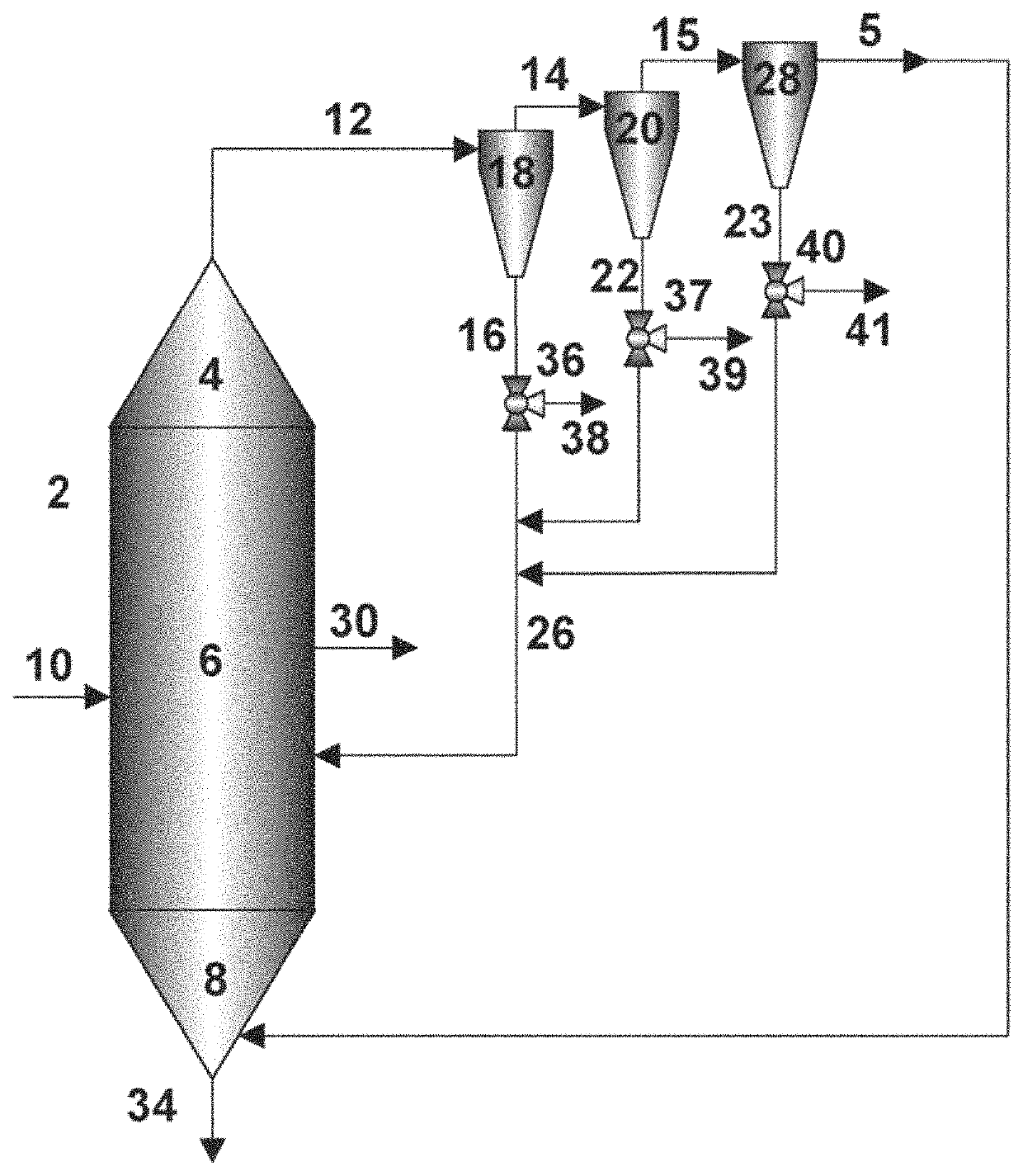Method, an arrangement and use of an arrangement of preparing polymer
a technology of polymer and arrangement, applied in chemical/physical processes, chemical apparatus and processes, etc., can solve the problems of high risk of reactor shut down, achieve better operability and performance of the reactor, reduce particle segregation, and more homogeneous mixing
- Summary
- Abstract
- Description
- Claims
- Application Information
AI Technical Summary
Benefits of technology
Problems solved by technology
Method used
Image
Examples
example 1
[0156]Ziegler Natta catalyst particles exhibiting a size distribution with d10 equal to 10 μm, d50 equal to 25 μm, and d90 equal to 40 μm, (i.e., span=1.0) were polymerized in a continuous PE pre-polymerization reactor at temperature equal to 70° C. and pressure equal to 65 barg using propane as solvent (2300 kg / h), 350 Kg / h ethylene feed rate, 0.1 KgH2 / tnC3, 40 KgC4 / tnC3 for a mean residence time of 30 min and with a mean measured catalyst activity equal to 2 Kg / gcat / h. Subsequently, the polymer material was transferred to a slurry loop reactor where it polymerized at temperature equal to 85° C. and pressure equal to 63 barg with hydrogen to ethylene ratio (expressed as mol per kmol) equal to 300 (H2 / C2=300), 1-butene to ethylene ratio (expressed as mol per kmol) equal to 600 (C4 / C2=600) with a solids concentration in the slurry-phase loop reactor equal to 37%-weight for a mean residence of 60 mins and with a mean measured catalyst activity equal to 18 Kg / gcat / h. After the loop rea...
example 2
[0159]The first example was repeated with the only difference being the operating conditions in the conventional bubbling fluidized gas phase reactor (GPR). Thus, the polymerization was carried out at temperature equal to 85° C. and overall pressure equal to 19 barg. 4.5 bar ethylene partial pressure was used and 1-butene was also added (co-polymerization conditions). The hydrogen to ethylene ratio (expressed as mol per kmol) was equal to 8 (H2 / C2=8) and the 1-butene to ethylene ratio (expressed as mol per kmol) equal to 650 (C4 / C2=650). In the GPR the polymer particles were polymerized for a mean residence time equal to 2 hours and with a mean measured catalyst activity equal to 18 Kg / gcat / h. The d10, d50 and d90 of the polymer particles produced in the gas phase reactor were measured (i.e., see Table 2). It can be observed that broad PSD is produced (i.e., span>2.5) which contributes in experiencing severe operability issues and fluidization instability challenges (solids segregat...
example 3
[0161]The second example was repeated with the only difference that after the flashing step the polymer particles were fed to a gas phase reactor having conical bottom and top zones in the absence of distribution plate and having an internal diameter equal to 3.6 m and cylindrical section height equal to 16 m. The superficial gas velocity was equal to 0.7 m / s and the reactor was connected in series with one cyclone having dimensions: inlet pipe diameter equal to 1.0 m, internal pipe diameter equal to 0.9 m, diameter of the cylindrical part equal to 1.8 m and overall height equal to 5.7 m. The solids flow rate at the inlet of the cyclone was 80 tn / h and the material flow rate removing from the bottom of the cyclone was 77.60 tn / h. The polymer particles are circulating between the reactor and the cyclone, and the small-size polymer particles are removed from the top of the cyclone upstream. It was also found that particles having size above 2.5 cm were collecting at the agglomeration ...
PUM
| Property | Measurement | Unit |
|---|---|---|
| median particle size | aaaaa | aaaaa |
| median particle size | aaaaa | aaaaa |
| median particle size | aaaaa | aaaaa |
Abstract
Description
Claims
Application Information
 Login to View More
Login to View More - R&D
- Intellectual Property
- Life Sciences
- Materials
- Tech Scout
- Unparalleled Data Quality
- Higher Quality Content
- 60% Fewer Hallucinations
Browse by: Latest US Patents, China's latest patents, Technical Efficacy Thesaurus, Application Domain, Technology Topic, Popular Technical Reports.
© 2025 PatSnap. All rights reserved.Legal|Privacy policy|Modern Slavery Act Transparency Statement|Sitemap|About US| Contact US: help@patsnap.com

